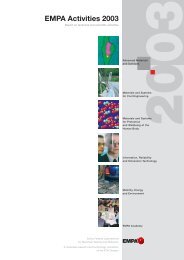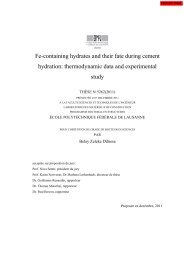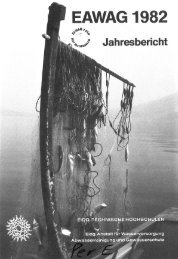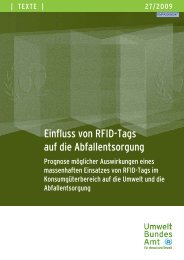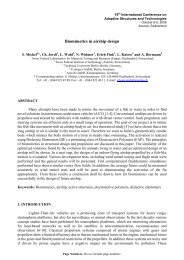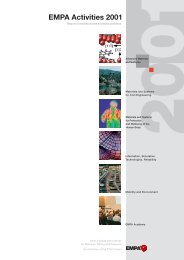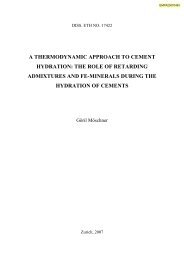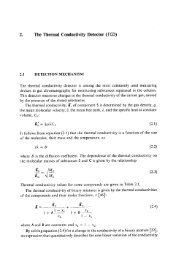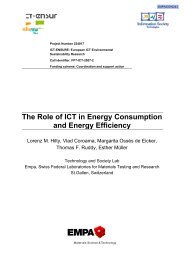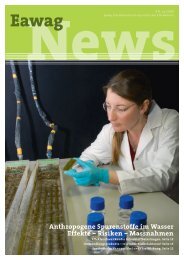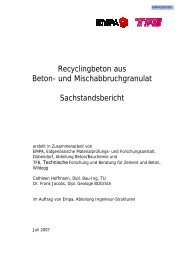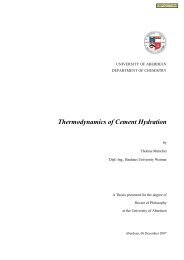Entire volume - Eawag
Entire volume - Eawag
Entire volume - Eawag
Create successful ePaper yourself
Turn your PDF publications into a flip-book with our unique Google optimized e-Paper software.
15 EAWAG news 58<br />
Brunhes<br />
normal polarity<br />
Matuyama<br />
reversed polarity<br />
Gauss<br />
normal polarity<br />
Gilbert<br />
reversed polarity<br />
Age<br />
(millions of years)<br />
Fig. 3: Reversals of the polarity of the geomagnetic<br />
field over the past 4 million years. In the light-blue<br />
time periods the polarity was the same as today; in<br />
the dark-blue periods the polarity was reversed. Some<br />
epochs are named after researchers dedicated to<br />
solving the riddles of the geomagnetic field.<br />
Geomagnetic field intensity<br />
1.5<br />
1.0<br />
0.5<br />
1<br />
2<br />
3<br />
4<br />
The Radioisotope Method<br />
The new radioisotope method is based on<br />
the analysis of polar ice cores. Although<br />
this ice consists almost entirely of only the<br />
purest of water, and contains effectively<br />
no magnetic particles, it can nevertheless<br />
reveal invaluable information concerning<br />
the history of the geomagnetic field. This<br />
information can be read from the trace<br />
amounts of radioisotopes, such as beryllium-10<br />
( 10Be) and chlorine-36 ( 36Cl), found in<br />
the ice. A strong geomagnetic field shields<br />
the earth from cosmic radiation, reducing<br />
the production of radionuclides. When the<br />
magnetic shield is “switched off”, however,<br />
the global nuclide production rate more than<br />
doubles. If we assume that the slow change<br />
in 10Be and 36Cl found in the ice is caused<br />
by the magnetic field, and that the faster<br />
solar variations are averaged out, then we<br />
have at our disposal a new, completely<br />
different method of reconstructing the historical<br />
strength of the geomagnetic field. It<br />
differs from the traditional methods in that<br />
its sensitivity actually increases with de-<br />
reconstructed from 10 Be and 36 Cl data from the GRIP ice core<br />
reconstructed from sediment core data from the Mediterranean Sea<br />
0<br />
20,000 30,000 40,000<br />
Years before present<br />
50,000 60,000<br />
Fig. 4: Reconstruction of the geomagnetic field strength over the time period 20,000 –60,000 years before present.<br />
Comparison of the radioisotope method (dark-blue curve: combined 10 Be and 36 Cl data from the GRIP ice core [2])<br />
with traditional methods (light-blue curve: orientation of magnetic particles in a sediment core from the Mediterranean<br />
Sea [3]). The gray band represents the range of uncertainty of the radioisotope method. The range of uncertainty<br />
of the traditional method is not shown.<br />
creasing field strength. Another advantage<br />
of this new method is that it is hardly affected<br />
at all by local variations in the magnetic<br />
field.<br />
Is the Radioisotope Method<br />
Reliable?<br />
In order to assess whether the radioisotope<br />
method does in fact produce reliable results,<br />
we have made a direct comparison of<br />
the two methods. Figure 4 shows the magnetic<br />
field strengths as reconstructed from<br />
10 Be and 36 Cl concentrations in the GRIP<br />
ice core from Greenland [2], and from traditional<br />
measurements of Mediterranean Sea<br />
sediment cores [3]. Apart from a few digressions,<br />
the results of the two methods agree<br />
well. The radionuclide measurements, for<br />
example, confirm that the earth’s magnetic<br />
field weakened about 40,000 years ago to<br />
around 10% of its current strength. However,<br />
just before a reversal of polarity could<br />
occur, it returned to its old state.<br />
The radioisotope method has therefore<br />
passed its baptism of fire. In the future, it<br />
can be used to analyze the entire time range<br />
covered by ice cores and sediment cores,<br />
thereby making it possible to reconstruct<br />
the geomagnetic field back to about one<br />
million years ago.<br />
And what about the future? When can we<br />
expect a new reversal of polarity? For about<br />
2000 years the magnetic field strength has<br />
decreased continuously, so if the rate remains<br />
constant we will experience another<br />
magnetic polarity reversal within about another<br />
2000 years. We humans will not notice<br />
this, but for migratory birds, which rely on<br />
the geomagnetic field for orientation, it is<br />
unclear what effect this will have on their<br />
ability to find their destinations.<br />
Jürg Beer, portrait on page 5.<br />
[1] Hongre L., Hulot G., Khokhlov A. (1998): An analysis<br />
of the geomagnetic field over the past 2000 years.<br />
Physics of the Earth and Planetary Interiors 106,<br />
311–335.<br />
[2] Wagner G., Masarik J., Beer J., Baumgartner S.,<br />
Imboden D., Kubik P.W., Synal H.-A., Suter M. (2000):<br />
Reconstruction of the geomagnetic field between 20<br />
and 60 kyr BP from cosmogenic radionuclides in the<br />
GRIP ice core. Nuclear Instruments and Methods in<br />
Physics Research B 172, 597–604.<br />
[3] Tric E., Valet J.P., Tucholka P., Paterne M., LaBeyrie L.,<br />
Guichard F., Tauxe L., Fontugne M. (1992): Paleointensity<br />
of the geomagnetic field during the last<br />
80,000 years. Journal of Geophysical Research 97,<br />
9337–9351.




